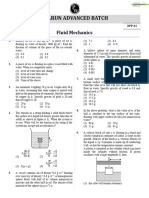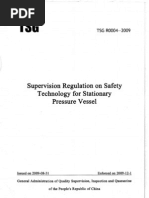Upthrust Practical Sheet
Uploaded by
s.sakimotoUpthrust Practical Sheet
Uploaded by
s.sakimotoPart 1: Investigating upthrust on objects in different liquids and how it is related to the volume of liquid displaced.
Tap water Questions:
1) Material 2) Weight (N) 3) Weight in 4) Upthrust (N) 5) Volume of 6) Mass of 7) Mass of 8) Mass of 9) Weight of water 1) How does the upthrust on each object compare
water (N) water measuring water water displaced (N) with the weight of water displaced?
displaced cylinder and displaced (g) displaced (kg)
(cm3) water (g)
(use Newtonmeter) (Column 2 - 3) Weight = mg
Saltwater
1) Material 2) Weight (N) 3) Weight in 4) Upthrust (N) 5) Volume of 6) Mass of 7) Mass of 8) Mass of 9) Weight of water
water (N) water measuring water water displaced (N)
displaced cylinder and displaced (g) displaced (kg)
(cm3) water (g)
(use Newtonmeter) (Column 2 - 3) Weight = mg
Part 2: Calculating pressure from depth, density and gravitational field strength
Tap water 2) What should the upthrust on the floating blocks be?
Material Length (m) Width (m) Surface area of Depth in Depth in Density Pressure (Pa) Upthrust (N)
block (m2) water (cm) water (m) (kg/m3) (P = F/A)
1000
1000
Saltwater
Material Length (m) Width (m) Surface area of Depth in Depth in Density Pressure (Pa) Upthrust (N) 3) If the block floated vertically, there would be a
block (m2) water (cm) water (m) (kg/m3) (P = F/A) greater pressure on the bottom of the block. Explain
why this would not increase the upthrust on the block.
1240
1240
You might also like
- A320 Airframe & Powerplant, Electro, Avionics Level 3 PDF93% (29)A320 Airframe & Powerplant, Electro, Avionics Level 3 PDF3,700 pages
- Pentair Pressure Relief Valve Engineering Handbook100% (1)Pentair Pressure Relief Valve Engineering Handbook233 pages
- Expt. No. 2 Determination of Roughness Coefficent of An Experimental Flume (Open Channel) AimNo ratings yetExpt. No. 2 Determination of Roughness Coefficent of An Experimental Flume (Open Channel) Aim4 pages
- A B Class Xi Part 4 Hydrostatics, Archimedes, Viscosity, Bernouli’s (2)No ratings yetA B Class Xi Part 4 Hydrostatics, Archimedes, Viscosity, Bernouli’s (2)7 pages
- Expt-2-Roughness Coefficient (Manning's N)No ratings yetExpt-2-Roughness Coefficient (Manning's N)4 pages
- PM - TB Solutions - Data-Based QuestionsNo ratings yetPM - TB Solutions - Data-Based Questions10 pages
- Study of Cooling System With Water Mist Sprayers: Fundamental Examination of Particle Size Distribution and Cooling EffectsNo ratings yetStudy of Cooling System With Water Mist Sprayers: Fundamental Examination of Particle Size Distribution and Cooling Effects9 pages
- Study of Cooling System With Water Mist Sprayers FNo ratings yetStudy of Cooling System With Water Mist Sprayers F10 pages
- Mechanical Properties of Fluids: Chapter TenNo ratings yetMechanical Properties of Fluids: Chapter Ten5 pages
- uploads1640269120DPP-2 (JEE Main) Fluid- Hydraulic Paradox, Pascal's Law, Archimedes PrincipleNo ratings yetuploads1640269120DPP-2 (JEE Main) Fluid- Hydraulic Paradox, Pascal's Law, Archimedes Principle30 pages
- Mechanical Properties of Fluids: Chapter TenNo ratings yetMechanical Properties of Fluids: Chapter Ten20 pages
- Prof. Sameer Unia - Tutorial Sheet _MCQs_ - Fluid Mechanics - 17-11-2024 (3)No ratings yetProf. Sameer Unia - Tutorial Sheet _MCQs_ - Fluid Mechanics - 17-11-2024 (3)9 pages
- Evaporative Cooling of Water in A Natural Draft Cooling TowerNo ratings yetEvaporative Cooling of Water in A Natural Draft Cooling Tower12 pages
- Reservoir Engineering Aspects Relate To Well LoggingNo ratings yetReservoir Engineering Aspects Relate To Well Logging46 pages
- The Fluid Mechanics of Floating and Sinking: Dominic Joseph Robert VellaNo ratings yetThe Fluid Mechanics of Floating and Sinking: Dominic Joseph Robert Vella142 pages
- Fluid Mechanics - DPP 01 - Varun JEE Advanced 2024100% (1)Fluid Mechanics - DPP 01 - Varun JEE Advanced 20245 pages
- A.B FLUID MECHANICS TO S.H.M NEET LEVEL QUESTIONNo ratings yetA.B FLUID MECHANICS TO S.H.M NEET LEVEL QUESTION9 pages
- uploads1640704633DPP-5 (JEE Main & Adv.) Fluid - Capillary Rise , Viscosity, Terminal VelocityNo ratings yetuploads1640704633DPP-5 (JEE Main & Adv.) Fluid - Capillary Rise , Viscosity, Terminal Velocity25 pages
- Case Studies in Fluid Mechanics with Sensitivities to Governing VariablesFrom EverandCase Studies in Fluid Mechanics with Sensitivities to Governing VariablesNo ratings yet
- Deep Marine Systems: Processes, Deposits, Environments, Tectonics and SedimentationFrom EverandDeep Marine Systems: Processes, Deposits, Environments, Tectonics and SedimentationNo ratings yet
- Design of Pressure Relief Valves For Protection ofNo ratings yetDesign of Pressure Relief Valves For Protection of11 pages
- Fluid Mechanics Prof. T.I. Eldho Department of Civil Engineering Indian Institute of Technology, BombayNo ratings yetFluid Mechanics Prof. T.I. Eldho Department of Civil Engineering Indian Institute of Technology, Bombay30 pages
- Design and Optimization OF A Vertical Turbine Pump - Empowering Pumps and Equipment100% (1)Design and Optimization OF A Vertical Turbine Pump - Empowering Pumps and Equipment12 pages
- Design Guideline For Hydraulic Fluid CleanlinessNo ratings yetDesign Guideline For Hydraulic Fluid Cleanliness24 pages
- Revealing Hydrocarbon Potential in A TigNo ratings yetRevealing Hydrocarbon Potential in A Tig32 pages
























































































